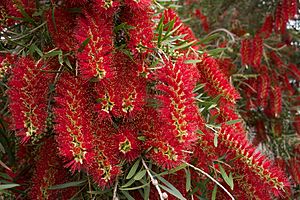Weeping bottlebrush facts for kids
Quick facts for kids Weeping bottlebrush |
|
|---|---|
 |
|
| Scientific classification | |
| Genus: |
Melaleuca
|
| Species: |
viminalis
|
| Synonyms | |
The Weeping Bottlebrush, also called creek bottlebrush, is a beautiful plant. Its scientific name is Melaleuca viminalis. It belongs to the Myrtaceae family, which includes plants like eucalyptus. This plant grows naturally only in New South Wales, Queensland, and Western Australia.
The Weeping Bottlebrush can be a large bush or a small tree. It often has many trunks and tough bark. Its branches usually hang down, which is why it's called "weeping." In spring and summer, it produces many bright red flowers that look like bottlebrushes. This plant is very popular in gardens around the world.
Contents
What Does the Weeping Bottlebrush Look Like?
The Weeping Bottlebrush is a large bush or small tree. It can grow up to 10 m (30 ft) tall. It has strong, grooved bark and many trunks. Its branches often hang down, giving it a graceful look.
Leaves and Their Features
The leaves grow one after another along the stems. They are usually between 25–138 mm (1–5 in) long and 3–27 mm (0.1–1 in) wide. The leaves are mostly flat and shaped like a narrow oval or egg. They are pointy at one end. You can see a main vein in the middle of the leaf. There are also 9 to 27 smaller veins branching off. If you look closely, you might see many tiny oil glands on the leaves.
Flowers and Fruit
The flowers are a vibrant red color. They grow in spikes at the ends of branches. These spikes are about 35–50 mm (1–2 in) wide and 40–100 mm (2–4 in) long. Each spike has 15 to 50 individual flowers. The petals are small, about 3.4–5.9 mm (0.1–0.2 in) long. They fall off as the flower gets older.
The most noticeable part of the flower is its many stamens. These are the parts that hold pollen. They are arranged in five groups around the flower. Each group has 9 to 14 stamens. The Weeping Bottlebrush usually flowers from September to December. However, it can often bloom at other times of the year too. After the flowers, small, woody seed pods called capsules form. These are about 3.8–4.8 mm (0.1–0.2 in) long and 5–6 mm (0.20–0.24 in) wide.
How the Weeping Bottlebrush Got Its Name
The scientific name Melaleuca viminalis was officially given in 2009. This happened when the plant's old name, Callistemon viminalis, was moved to the Melaleuca group. The first part of its name, Melaleuca, is the genus it belongs to.
Meaning of "Viminalis"
The second part of the name, viminalis, comes from a Latin word, vimen. This word means "pliant twig" or "osier." It describes how the branches of this plant often hang down, like weeping willow branches.
Different Types of Weeping Bottlebrush
There are two main types, or subspecies, of the Weeping Bottlebrush:
- Melaleuca viminalis subsp. viminalis: This type is a multi-trunked bush or small tree. It can grow up to 15 metres (50 ft) high. It often flowers throughout the entire year.
- Melaleuca viminalis subsp. rhododendron: This type is a single-stemmed tree. It can grow much taller, up to 35 metres (100 ft) high. It mostly flowers in September and October. This subspecies is only found in the Injune area of Queensland.
Where the Weeping Bottlebrush Grows Naturally
This bottlebrush plant is found along the eastern coast of Queensland. It grows from the Cape York Peninsula down to Moree and Grafton in New South Wales. You can also find smaller, separate groups of these plants in far northern and southwestern Western Australia. It usually grows near or in water, like along rivers and streams. It prefers areas with sandstone or granite rocks.
How the Weeping Bottlebrush Helps Nature
The Weeping Bottlebrush is important for local wildlife. Its flowers produce nectar, which is a sweet liquid. This nectar provides food for nectivores, which are animals that eat nectar. Examples include birds and insects.
This plant also plays a big role in protecting rivers. Its strong roots and flexible branches help slow down fast-moving water during floods. This reduces erosion of the riverbanks. By doing this, it helps keep the water in streams and rivers cleaner. The thick roots also make the soil on riverbanks stronger, which further prevents the land from washing away.
Growing Weeping Bottlebrush in Gardens
The Weeping Bottlebrush is a very popular plant for gardens and street planting. It is often known by its old name, Callistemon viminalis, in nurseries. It's a tough plant that can grow well in most types of soil. It needs to be planted in a sunny spot.
This plant is great for creating a screen or hedge. It also makes a good street tree. Young plants need regular watering. However, once they are grown, they can survive periods of dry weather. It's important to know that this plant doesn't like frost or salty air.
Popular Types for Gardens
Many special types, called cultivars, of the Weeping Bottlebrush have been created for gardens. These are usually sold under the Callistemon name. Some popular ones include:
- C. viminalis 'Captain Cook'
- C. viminalis 'Rose Opal'
- C. viminalis 'Dawson River Weeper'
- C. viminalis 'Hannah Ray'
- C. viminalis 'Prolific'
- C. viminalis 'Hen Camp Creek'
- C. viminalis 'Wild River'
Images for kids
See also
 In Spanish: Callistemon viminalis para niños
In Spanish: Callistemon viminalis para niños


